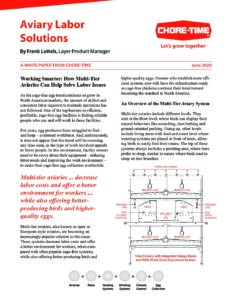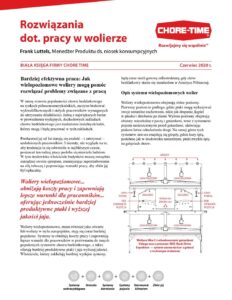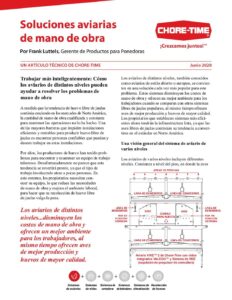White Paper:
Aviary Labor Solutions
Working Smarter: How Multi-Tier Aviaries Can Help Solve Labor Issues
As the cage-free egg trend continues to grow in North American markets, the amount of skilled and consistent labor required to maintain operations has not followed. One of the top barriers to efficient, profitable, cage-free egg facilities is finding reliable people who can and will work in these facilities.
For years, egg producers have struggled to find — and keep — a talented workforce. And, unfortunately, it does not appear that this trend will be reversing any time soon, as the type of work involved appeals to fewer people. In this environment, facility owners need to be savvy about their equipment — reducing labor needs and improving the work environment — to make their cage-free egg collection worthwhile.
Multi-tier aviaries, also known as open or European-style aviaries, are becoming an increasingly popular solution to this issue. These systems decrease labor costs and offer a better environment for workers, when compared with other popular cage-free systems, while also offering better-producing birds and higher-quality eggs. Owners who establish more efficient systems now will have the infrastructure ready as cage-free chickens continue their trend toward becoming the standard in North America.
Multi-tier aviaries … decrease labor costs and offer a better environment for workers … while also offering better-producing birds and higher-quality eggs.
An Overview of the Multi-Tier Aviary System
Multi-tier aviaries include different levels. It starts at the floor level, where birds can display their natural behaviors like scratching, dust bathing and ground-oriented pecking. Going up, other levels include living areas with feed and a nest level where watering systems are placed in front of nests, allowing birds to easily find their routes. The top of these systems always includes a perching area, where hens prefer to sleep, similar to nature where birds tend to sleep on tree branches.
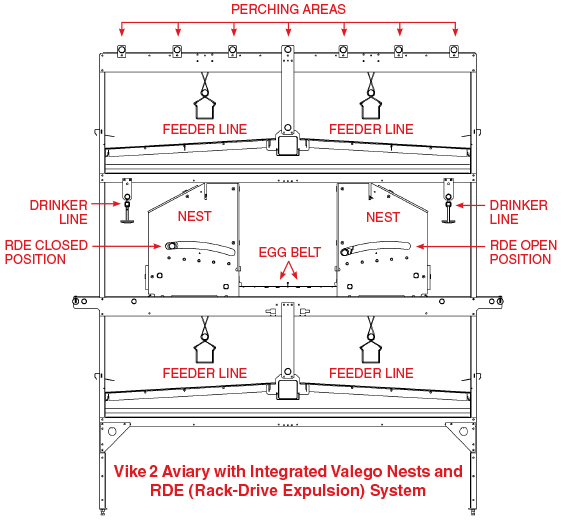
The design of these systems is based on the animals’ natural behaviors. Intentional aspects of each level “nudge” birds to participate in particular activities in the desired location. Most of these systems are outfitted with wire mesh and manure belts at each level to preserve a sanitary and healthy environment. Overall, multi-tier aviaries aim to eliminate manual labor and self-sustain as much maintenance as possible.
Overall, multi-tier aviaries aim to eliminate manual labor and self-sustain as much maintenance as possible.
For example, Chore-Time’s VIKE Aviary System features nipple drinkers to automate watering and minimize spilling. Its auger-driven feeding system distributes a uniform feed ration across the entire length of the system, so birds cannot select and consume choice morsels of feed. This frees up time for a smaller labor force to take care of the few remaining manual tasks.
Other cage-free options, including combination and floor systems, require significant manual labor for everyday tasks. Experts estimate that floor systems require two to three times the amount of labor, while combination systems can require up to five times as much, especially with a poor house design. Workers in these systems will also need to be highly skilled in handling and wrangling birds. Any money saved from the initial equipment and installation investments is soon lost to overhead costs.
Industry leaders are switching to multi-tier systems to reduce labor requirements for their cage-free chicken rearing, breeding, and egg production facilities. Here are some of the processes that multi-tier aviaries either improve or eliminate the need for entirely:
- Manual hen placement and dispersion
- Hen organization and access
- Egg sorting and sanitation
Reduced Need for Manual Hen Placement and Management
Hens naturally tend to sleep at the top of their housing. In other cage-free systems, too many birds sometimes congregate together, creating hot spots and overcrowding. These can lead to unsanitary conditions, unnecessary stress on the animals and even the deaths of otherwise healthy hens. To counter such issues, other types of cage-free systems need much more overall house management. They also tend to require an overabundance of nests. This, in turn, can decrease the quality of the eggs and overtax the egg belts in egg collection facilities.
Because multi-tiered aviaries are built to influence hen behavior, manual bird management is eliminated. Birds enjoy the different levels at different times, allowing for a more even spread of hens throughout the system. In perching areas, hens naturally spread out, allowing for improved ventilation without manual intervention. In rearing facilities, pullets can build muscle by moving around in open space and jumping between different levels.
Because multi-tiered aviaries are built to influence hen behavior, manual bird management is eliminated.
Additionally, the labor learning curve for multi-tier aviaries is much lower than other options. Because hen behavior is more consistent and predictable, workers need less training and can be found more readily.
Easier Access and Organization of Hens
Accessing and discovering where certain birds are located consumes a large portion of the workday for most cage-free systems. Because birds are not easily contained, chickens intermingle and are harder to manage. Along with requiring more time from workers, this task is frustrating and requires skilled farmhands. Between a lower enjoyment of the work and a higher threshold of skill, this leads to more labor costs and less worker retention.
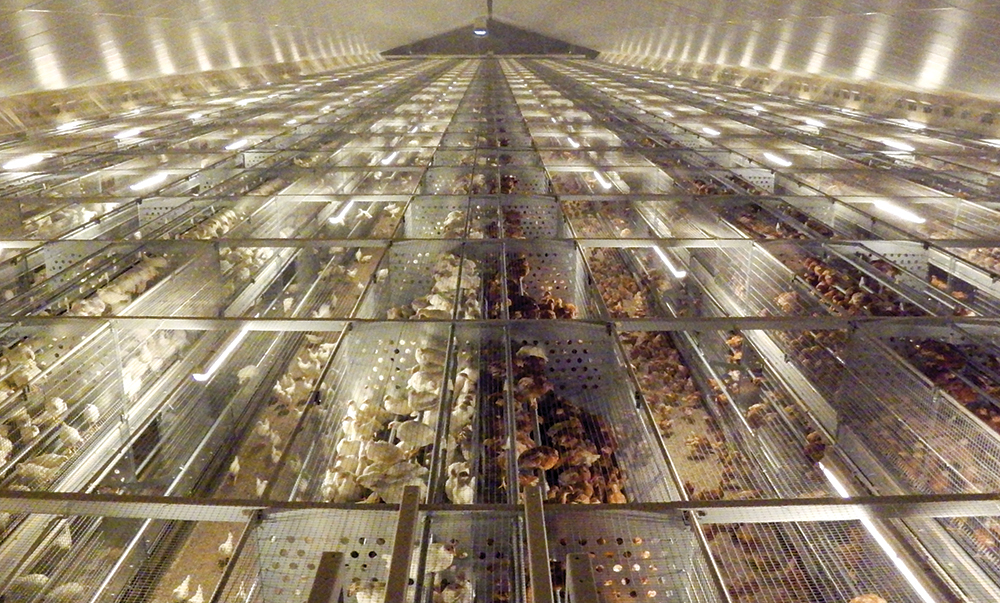
In aviary rearing systems, birds are well distributed, and the use of vertical space allows for easy access and organization. Birds can be separated by breed, and pullets can be secured away from more mature birds for protection. The image [below] shows a multi-tier aviary facility with 100,000 birds in separate aviaries.
Ease of access cuts labor time and improves the working experience. Chore-Time’s VOLUTION system, for example, offers double sliding doors, allowing workers easy entry into and out of the system. Time spent on manual processes, like vaccinating hens or maintaining equipment, is cut significantly.
Automated Egg Collection
In egg collection facilities, multi-tier aviaries can automate much of the manual labor required for egg quality control and collection. Because hens prefer to lay their eggs in dark, sheltered places, the LED lights at the bottom level dissuade hens from laying floor eggs and encourage them to seek out the nests on the second level. In other systems, workers need to go in the house and individually collect eggs laid in the wrong place. Besides the lost time collecting these eggs, broken floor eggs can cause messes that need to be cleaned up, further increasing required labor.
In multi-tier aviaries, a gentle collection system on the second level minimizes cracking and automates the task. This means more high-quality eggs with less work.
Chore-Time’s VIKE aviary also features an innovative Rack-Drive Expulsion (RDE) system in the nesting area. To prevent hens from spending too much time in the nesting area at the end of the day, defecating and sullying eggs, the RDE system slowly pushes them out of the second level over time. This reduces time spent cleaning the eggs and manually moving hens.
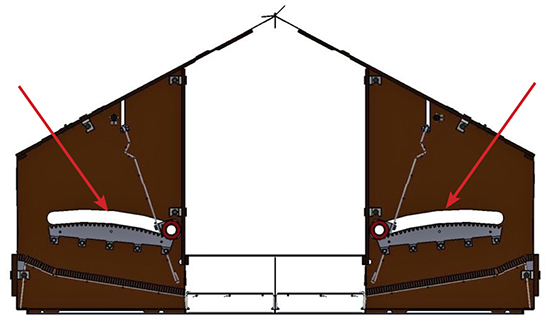
The Future of Cage-Free Systems
Higher demand for cage-free eggs means greater opportunity for producers. However, demand cannot be met without the appropriate labor. The solution, it seems, is a system that practically manages itself. Multi-tier aviaries come close to doing just that.
These systems are more than a solution to labor issues, as the benefits of multi-tier aviaries do not disappear when the labor pool is abundant. In time, the more efficient cage-free system will overtake the market. Producers who are raising better chickens, collecting higher-quality eggs, and doing so with reduced overhead and full production in a sparse labor market, will soon find themselves far ahead of the competition.
